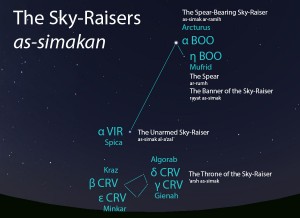Elements of the Celestial Complex
The Two Sky-Raisers (as-simakan, السماكان)
The Unarmed Sky-Raiser (as-simak al-a’zal, السماك الأعزل)
The Spear-Bearing Sky-Raiser (as-simak ar-ramih, السماك الرامح)
The Spear (ar-rumh, الرمح)
The Throne of the Sky-Raiser (‘arsh as-simak, عرش السماك)
In ancient Arabic, the term simak indicated something that was used to raise something else high up. When the Two Sky-Raisers reached the midpoint of their travels across the night sky, the uppermost one was almost at the zenith, right over your head, and the lower Sky-Raiser was almost directly below it, about halfway up the sky. The Two Sky-Raisers were the pillars that held up the canopy of the heavens.
The Spear-Bearing Sky-Raiser is the higher one of the Two Sky-Raisers (as-simakan), and for this reason it was sometimes called the Watcher. The Spear-Bearing Sky-Raiser is so named because it has a bright star close to it that is said to be the Spear (ar-rumh) that it has thrown. The alternate name for this star, the Banner of the Sky-Raiser, was also common and recalled the military standard used in battle. The lower, Unarmed Sky-Raiser is called “unarmed” because it does not have a bright star close to it like the Spear-Bearing Sky-Raiser does, but it does have a Throne (‘arsh as-simak).

Wide-field view of the Sky-Raisers (as-simakan) and their elements as they appear when its Throne (al-‘arsh) is setting in mid-March. Sky simulations made with Stellarium.
Appearance
A pair of very bright stars that are spaced widely apart. The northern star has a moderately-bright star located close to it. The southern star has near it a grouping of four moderately bright stars that is arranged in a quadrilateral shape.
Modern Identification
The Unarmed Sky-Raiser and its Throne:
α VIR (Spica), blue-white star, magnitude 1.0
β CRV (Kraz), yellow giant star, magnitude 2.7
δ CRV (Algorab), white double star, magnitudes 3.0 and 8.4
γ CRV (Gienah), blue-white star, magnitude 2.6
ε CRV (Minkar), yellow star, magnitude 3.0
The Spear-Bearing Sky-Raiser and its Spear:
α BOO (Arcturus), red giant star, magnitude 0.0
η BOO (Mufrid), white star, magnitude 2.7
Timing
The Two Sky-Raisers set about 40 days apart but rise within a week of each other. Ibn Qutayba (d. 879 CE) reported that the Unarmed Sky-Raiser (the first of the pair to set and the second to rise) was said to rise on the morning of October 6 and set on the morning of April 5. On account of the precession of the equinoxes, today we can expect to observe the Two Sky-Raisers and the Throne setting from mid-April through early June, and rising in mid to late October, as seen from the latitude of Tucson.
Rain Stars
In the calendars of Qushayr and Qays, the morning settings of the Two Sky-Raisers defined the start and end of the short rainy season of summer (as-sayf). In this calendar, the Spear-Bearing Sky-Raiser is referred to as the Watcher (ar-raqib).
Lunar Stations
Because the ecliptic (the path of the Moon against the stellar background) passes through the Unarmed Sky-Raiser, within the context of the lunar stations only it, and not the Spear-Bearing Sky-Raiser, had the honor of being a lunar station. In early listings of the lunar stations, the Unarmed Sky-Raiser is the 16th station of the year. This was later changed to the 14th lunar station after the stations were adjusted to begin with the vernal equinox.

